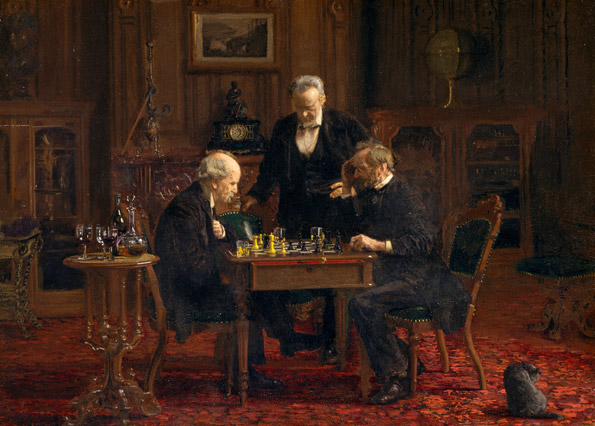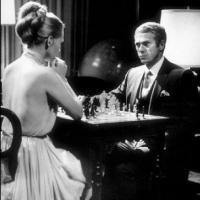Thomas Eakins (American, 1844–1916). The Chess Players, 1876. Oil on wood. The Metropolitan Museum of Art, New York, Gift of the artist, 1881 (81.14)
Who would have thought there could be a connection between chess and Valentine's Day? Growing up, my image of chess pretty much corresponded to the Thomas Eakins painting shown above: graying gentlemen gathered around a table in a dimly lit sitting room, with only a glass of port to warm things up. Indeed, as a game that focuses on battle strategy (see "An Epic Battle"), chess seemed to me to be pretty much "a guy thing."
Film still from The Thomas Crown Affair, 1968
Not until the original version of The Thomas Crown Affair was shown on television did I imagine that playing chess could be a seductive act. Anyone who remembers the chess scene with Steve McQueen and Faye Dunaway—I saw it in my college dorm and it remains indelibly etched in my mind—knows it's true. What I didn't know then is that chess has been linked to romance and seduction since the Middle Ages.
A Parisian ivory plaque in the Metropolitan's collection, currently on view in The Game of Kings, is a good example. At the upper left, an overly ardent suitor embraces a woman, who rebuffs him. At the upper right, his luck improves, as he sits on a bench with a young woman, puts one arm around her shoulder and gently cradles her chin in his hand. At lower left, the young man plays chess with a maiden. She holds several pieces in her hand—has she won the game or simply accumulated a few pieces of no consequence? In the fourth scene, our young lover kneels at the feet of a woman. Does this represent the pursuit of one woman, or as many as four? The women's coiffures and headdresses change from one scene to the next; the man's appearance is constant. A chess match is just one strategy among several that he uses, and a far more successful one than his initial, aggressive approach.
Plaque with Scenes of Courtship, 14th century. French. Ivory. The Metropolitan Museum of Art, New York, Gift of Ann Payne Blumenthal, 1938 (38.108)
The plaque was originally used as a writing tablet. The slight indentation on the back (shown above, right) would have accommodated a thin layer of wax on which messages could be written, then erased—a sort of medieval version of texting. The courtship scenes carved on the front suggest that the messages were more likely love notes than to-do lists.
The Garden of Love, ca. 1510–20. South Netherlandish, made in Brussels. Wool warp; wool, silk, and metallic wefts. The Metropolitan Museum of Art, New York, Gift of Mrs. Van Santvoord Merle-Smith, 1942 (42.202)
In a sixteenth-century tapestry in the Museum's collection, playing at tarot cards (left) and chess (right) are the entertainment for a group of gentlemen and ladies keeping company in the open air. One couple watching the chess game looks on and whispers. The lady playing the game holds one fallen piece in her hand while her opponent makes a move.
Liberale da Verona (Italian, 1445–1527/29). Left: Scene from a Novella. Tempera on wood. The Metropolitan Museum of Art, New York, Gwynne Andrews Fund, 1986, 1986.147; Right: The Chess Players, ca. 1475. Tempera on wood. The Metropolitan Museum of Art, New York, Maitland F. Griggs Collection, Bequest of Maitland F. Griggs, 1943 (43.98.8)
On two late fifteenth-century panels from a cassone, or chest, by Liberale da Verona, a lady first invites a young man upstairs, and then plays him at chess as their friends look on. The board offers a means for them to sit close to each other; notice how the lady looks coyly away but touches the gentleman's arm as he prepares to move his piece.
On an ivory mirror case in the Victoria & Albert Museum, a chess match becomes the setting for a tête-à-tête. In this unfolding love affair, the lady holds several pieces in one hand, but raises her free hand and reaches toward her opponent—perhaps in surprise?—as the young man makes his move.
Medieval literature often uses chess as a metaphor for a budding romance. Sir Lancelot sends a knight with a gift of magical silver-and-gold chessmen to Guinevere with the message: "My Lady, Sir Lancelot sends you these chessmen in the belief that you've never seen any more wondrous, though possibly some as beautifully crafted." Elsewhere, in medieval French romances, like the thirteenth-century Huon of Bordeaux, or the fourteenth-century The Vows of the Peacock, the language of chess and the language of seduction become almost interchangeable. The chess match in The Vows of the Peacock even takes place in the so-called Chamber of Venus.
In the adventures of Huon of Bordeaux, a chess board is set for Huon's match against an exotic princess (see image). The stakes are high: if he loses, he will be put to death; if he wins, he will spend the night with the princess. Huon asks, "Lady, what game will you play at?" She, immediately struck by Huon's good looks, replies "At the usual game, to be mated in a corner." The dialogue would have been perfectly suited to The Thomas Crown Affair, in which, after losing the chess game, Steve McQueen says, "Let's play something else."
The citations from the story of Lancelot are taken from Lancelot-Grail: The Old French Arthurian Vulgate and Post-Vulgate in Translation: Lancelot parts V and VI, translated by William W. Kiblert and Carleton W. Carroll, Cambridge, 2010, p. 143 (available in part on Googlebooks). Other citations from H. J. R. Murray, A History of Chess, Oxford, 1913.




